Hammers & Mallets
Steel Blocks, Dapping, Chasing, Cross Peen Hammers ... what?!

Of all my beloved jewelry tools, hammers and mallets are perhaps one of the last ones to make their way into my arsenal. The plentitude of these jewelry tools for your craft can seem to be quite mystifying at the start. I am but a beginner in this area, but I think this will be long love-affair. The specific and various uses for these tools I think you will find, are just an eye-opener and to me, quite mesmerising!
Hammering Terminology
I found the terminology here, to start off with, quite bewildering. The terminology does take a bit of getting used to. So here are some of the very basics to get us all started. It will also make much more sense as to why these craftsman tools have the names that they do.
- chasing & repousse - both are metal working techniques to produce designs and relief patterns on the metal. Chasing is worked from the front of the metal; repousse from the back/reverse side.
- cross peen - aka cross pein - is when there is a wedge-shaped head, perpendicular to the handle.
- mallet - are made of softer material than steel hammers; e.g. rubber, nylon, rawhide, wood, plastic. They are used for hammering without leaving behind unsightly marks. The mallet head normally has a flat or slightly convex striking surface.
- peening - hammering to spread and harden the metal
- planishing - smoothing out imperfections and slight indentations on a metal sheet. Often after the metal has been roughly formed (e.g. via sinking or raising), the surface will have some irregularities. Planishing is hammering the piece using either the smooth or slightly curved head of a planishing hammer, on a steel block.
- raising - creating a convex shape of metal by forcing it into a hollow object (e.g. bowl) by hammering it on a stake, thereby stretching it into the desired shape
- sinking - aka embossing, doming, dapping, dishing - process of forcing metal into ares that are domed, cupped, curved - often with the intent of creating low reliefs
- work harden - where a piece of wire or metal sheets gets hardened/stiffer (feels stronger) from hammering it
Metal & Wirework - Hammers and Mallets
-
anvil (steel bench block)
Used in conjunction with a Chasing Hammer or Rubber mallet to flatten and harden metal and wirework.
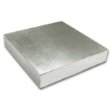
-
rubber bench block
Used beneath a steel bench block to absorb shock and protect table/workbench beneath. Alternatives include wood or leather pads for absorption.
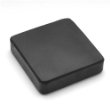
- Dapping Block
For shaping, removing dents, and doming metal sheets. Various sizes. Made from steel or wood. Some steel ones have a flat smooth surface on the other side and doubles as a bench block.

-
Ball Peen/Ballpein Hammer
One of the most common hammer types; found in most hardware stores. However ball peen hammers for jewelry is usually slightly smaller. Has a flat and domed end. Used for flattening, shaping. Can be used with chisels and punches.
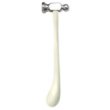
- Brass Hammer or Mallet
Will not produce spark like a steel head hammer does. Used to repair jewelry or resize rings when the nylon/rawhide mallets are insufficient. Leaves a bit of marring but less than steel hammers.
-
Cross Peen/Cross Pein Hammer
Has a wedge shape face, perpendicular to the handle. For shaping and spreading the surface of metal. Will also work harden the metal in the process. Can also be found in Hardware stores.
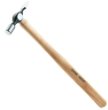
-
Chasing Hammer
usually used with a steel bench block. For hardening wire, flattening wire, texturing metal, indenting wire and metal. Flat round surface on one side and small round embossing end on the other. Weight of this hammer is important: one that give an easy bouncy rhythm to prevent stress to body during use.
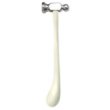
- Deal Blow Mallet or Hammer
Very popular with jewelry makers. It is hollow and filled with sand or steel shot. Made from polyurethane or urethane. Will not mar nor scratch. Absorbs impact (less bounce-back or rebound).

- Embossing Hammer aka Sinking Hammer
Gives dimension to metal sheet. Used to force metal into curved or cupped surfaces. Useful for repousse work (shaping metal from reverse side to create low reliefs.

- Forming Mallet - aka Horn Forming Mallet, or just Horn Mallet
Was named Horn Mallet because traditionally was made from the solid end of a cow's horn. Has a flat and a conical end. Flat end for general forming; conical end (cross peen end) for more precise shaping. Nylon Forming Mallet will not mar the metal work.

- Planishing Hammer
Usually with a flat and a slightly domed head. Works out ridges and imperfections, especially after forming with other techniques. The head stretches metal in all directions. Works best with soft blows to avoid adding dimples to the metal. Suitable for flattening metal and wire.

-
Raising Hammer
One of the most expensive types of hammers. Used especially in early stages of forming shapes. The corners should be rounded to prevent marring the metalwork. Used to stretch metals sheet into convex shape.

- Riveting Hammer aka Riveting Chisel
Used for spreading rivet heads and ideally, lightweight (the thin cross peen end). The other flat end for leveling rivets and other general hammering. Ideal for light metal work, favoured by jewelry and watch makers.

-
Texturing Hammer (for adding texture)
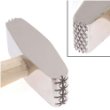
-
Utility Hammer/Mallet (plastic, rubber, rawhide, nylon)
Used with softer metals, leather. Will not mar or damage surface. Use to harden wire without marring.
These can often be found at hardware stores as well.
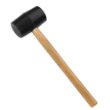
Care and Notes on the Common Steel Hammer
Majority of hammers are made from steel. However good quality steel is hardened tool steel - which will rust. Stainless steel, which does not rust, seems to be the obvious best choice. However stainless steel is an alloy that is softer than tool steel.
Recommendation: go with the quality hardened tool steel. To prevent rusting, protect from moisture by oiling them.
- Return to Jewelry Making Beads Library Home > Jewelry Making Supplies
- Back to top of Hammers

Like This Page?
New! Comments
Have your say! Leave a comment or suggestion in the box below.